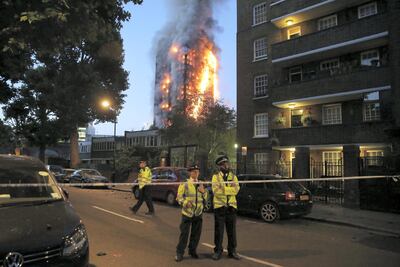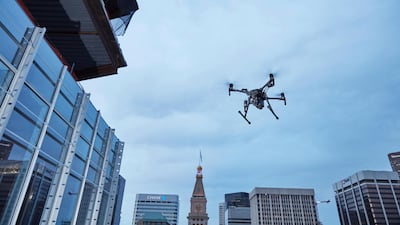UAE scientists are aiming to make drones lighter, stronger and weather-resistant – to tackle skyscraper fires and even deal with fog.
Researchers at Khalifa University in Abu Dhabi have found that a "sandwich-style" structure for drones could lower their weight without compromising on strength, allowing them to swoop in during emergency situations more efficiently.
Dr Yahya Zweiri, an associate professor at the university who led the research, was prompted to take action by the devastating blaze that hit the 24-storey Grenfell Tower in London in June 2017, killing more than 70 people.
There have also been fires in some of the UAE's high-rise towers, among them the 79-storey Torch tower, which suffered blazes in 2015 and 2017.
As well as looking into how drones that are used to fight fires could be improved, Dr Zweiri is also interested in helping to develop craft that can cope with other types of extreme circumstances, including humid air, foggy conditions and high levels of sand – all conditions that are experienced in the UAE.
As the researchers describe in a paper in the journal Polymers, the sandwich-like arrangement consists of a central layer of a low-density material called acrylonitrile butadiene styrene/carbon (ABS) that has been fabricated using a 3D-printing machine.
Among the advantages of this material are that it is lightweight, relatively inexpensive and that structures can be crafted from it with relatively simple 3D printers.
Keeping weight within strict limits is important for unmanned aerial vehicles, because this reduces the battery energy required for the craft to lift off from the ground and fly.
However, on its own, the drone lacks strength, so layers of a “skin” made from carbon-fibre reinforced polymer (CFRP) are added on each side of the ABS to create the sandwich.
“What encouraged us to do this sandwich was that we could use existing 3D printing that is cheap and available,” said Dr Zweiri.
CFRP is strong and able to bear significant weight because it is a composite made of carbon fibres embedded in resin.

Its remarkable properties mean that it is becoming a favourite material in the manufacturing of airliners.
The aircraft manufacturer Airbus says that CFRP has a greater strength-to-weight ratio, and is less likely to corrode or to suffer from fatigue, than metal.
Indeed Airbus's 350XWB (extra wide body) airliner, a cutting-edge model that made its first flight only in 2013, makes extensive use of CFRP in both its fuselage and wings.
In Dr Zweiri's study the addition of CFRP layers led to a nine-fold increase in the strength of drone structural material.
The Young's Modulus, a measure of how easily a material can stretch and deform, was also 16 times greater in the sandwich structure compared to the original, which is important because some drone materials have tended to be brittle.
Tests showed that, as additional layers of CFRP were added, the strength continued to increase.
The layered structure, described by Dr Zweiri as being “competitive in terms of price and value”, was tried out by using it in clamps that held the propeller arms in place in quadcopter drones.
The research was an international project that also involved Dr Hany Hassanin at the University of Liverpool in the United Kingdom and Athanasios Galatas at Kingston University in London, with which Dr Zweiri is also associated. The other collaborator was Professor Lakmal Seneviratne at Khalifa University.
Dr Zweiri is now exploring the potential for the lighter, stronger structures that the research has developed to be used in firefighting drones.
Because their structural sections are less heavy, such drones could have a thin heat-resistant ceramic layer added to their surface without the craft's weight increasing too much.
This means that there would be no additional demands on the battery when the drone flies, allowing drones to spend longer in the air without needing to be recharged..
“We've reduced the weight of the platform to save energy and to give us room where we can add the nano-ceramic material to make it more resistant to the high temperatures,” said Dr Zweiri.
“We don't want to solve one problem to create another. What's the use of us making it able to operate at 500°C if the endurance comes down from 20 minutes to 10 minutes?”
Firefighting drones could be particularly useful in combating high-rise building fires, which could be of great value in the UAE.
Although a single drone might have a relatively modest payload of several tens of litres of water, Dr Zweiri envisages the use of multiple drones simultaneously or in waves, making them more effective at dealing with blazes that firefighters cannot get near to.
“You can have a swarm of them – maybe 10 to 20 UAVs. Once they become empty, the others come in a wave,” said Dr Zweiri, adding that they could be spread around a blazing building.
Multiple drones could be kept “in readiness”, allowing them to be used rapidly should a fire break out nearby.
“At an early stage the fire will be limited and these UAVs will be very effective,” he said.


